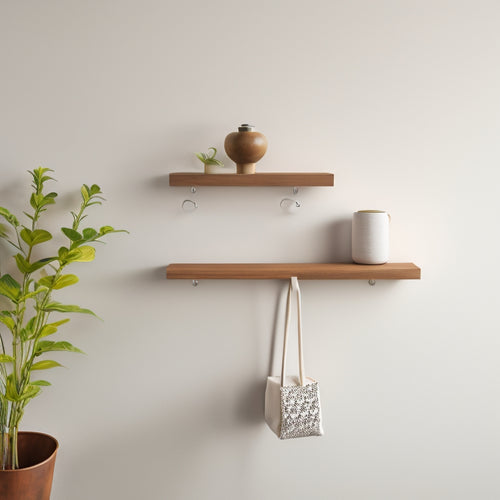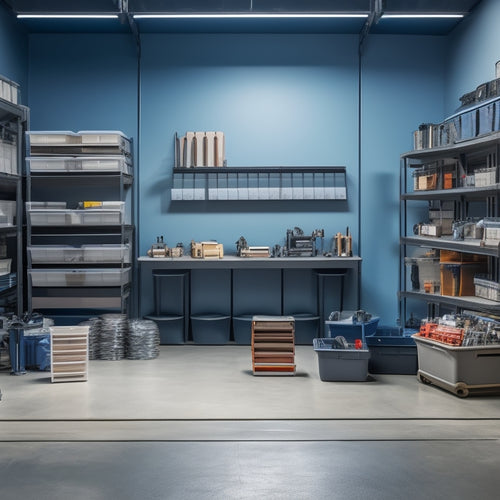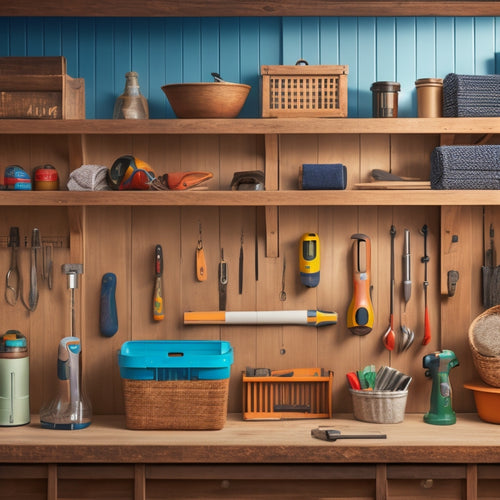
Create a Custom Tool Storage Plan in Minutes
Share
You can create a custom tool storage plan in minutes by leveraging downloadable templates that provide a pre-designed framework for organizing your tools and maximizing your garage layout's space and efficiency. Start by grouping similar tools together and designating a "launching pad" for frequently used tools. Assess your available space and constraints, then optimize your workspace dimensions for efficient storage. Consider the layout and utilization of corners or alcoves, and implement vertical storage solutions like pegboards or shelves. As you get started, you'll discover how to tailor your plan to fit your unique workflow and preferences.
Key Takeaways
• Use downloadable tool storage templates to streamline your plan and maximize space and efficiency in your garage or workshop.
• Identify your tool storage needs by taking stock of your current tool inventory and categorizing tools by size, type, and frequency of use.
• Customize your plan by grouping similar tools together, designating a 'launching pad' for frequently used tools, and leaving space for growth and flexibility.
• Optimize your workspace dimensions and utilize vertical storage solutions like pegboards or shelves to maximize storage efficiency.
• Label storage compartments and assign specific locations for each tool to ensure easy identification and accessibility in minutes.
Downloadable Tool Storage Templates
You can streamline your custom tool storage plan by utilizing downloadable tool storage templates, which provide a pre-designed framework for organizing your tools and equipment. These templates help you create a garage layout that maximizes space and efficiency, ensuring you can find what you need quickly and easily.
With a well-organized workshop setup, you'll be able to tackle DIY projects with confidence, knowing exactly where to find the necessary tools.
Downloadable tool storage templates cater to various tool organization needs, from simple to complex setups. You can choose a template that suits your specific requirements, whether you're a DIY enthusiast or a professional contractor.
These templates often include customizable fields, allowing you to input your tool inventory and assign specific storage locations. This helps you maintain a tidy and organized workspace, reducing clutter and increasing productivity.
Customizing Your Tool Storage Plan
With your tool storage template in hand, customizing your plan becomes a matter of assigning specific tools to designated storage locations and tailoring the layout to fit your unique workflow and preferences. This is where you get to make the plan truly yours, ensuring that every tool has a home and is easily accessible when you need it.
To customize your tool storage plan effectively, consider the following:
-
Group similar tools together: Store tools that are used for similar tasks or projects in the same area to improve tool organization and reduce workflow disruptions.
-
Designate a 'launching pad': Identify a central location where you'll store frequently used tools, making it easy to grab what you need and get to work quickly.
-
Leave space for growth: Don't overcrowd your storage spaces – leave some room for new tools or unexpected needs, ensuring your storage customization remains flexible and adaptable.
Identifying Your Tool Storage Needs
As you begin to identify your tool storage needs, you'll want to take stock of your current tool inventory by making a list of every tool you own, including their size, type, and frequency of use.
This assessment will help you pinpoint which tools require dedicated storage space and which can be stored together. By understanding your current storage challenges, you'll be able to pinpoint the pain points that your custom tool storage plan needs to address.
Tool Inventory Assessment
Taking stock of your tool collection is essential in identifying your storage needs, and this assessment begins with a thorough count and categorization of every item in your arsenal. You'll want to gather all your tools and equipment, from hammers and screwdrivers to power tools and accessories, and group them into categories that make sense for your work style.
Some categories to assess include:
- Hand tools: wrenches, pliers, screwdrivers, etc.
- Power tools: drills, saws, sanders, etc.
- Fasteners and fixings: nails, screws, bolts, etc.
- Measuring and testing tools: levels, tape measures, multimeters, etc.
As you categorize your tools, think about how you use them and how often they're needed. This will help you determine the most efficient storage solutions for each group.
Effective tool organization is key to maximizing your storage space and reducing clutter. By understanding your tool inventory, you'll be able to design a custom storage plan that meets your unique needs and improves your workflow.
Current Storage Challenges
What specific storage frustrations do you face daily, and how do they hinder your productivity and workflow? Are you tired of wasting time searching for misplaced tools or struggling to find space in your overcrowded workshop? These challenges can be overwhelming, but identifying them is the first step towards creating a customized tool storage plan that works for you.
Take a closer look at your current storage system and evaluate its efficiency. Are there areas where clutter accumulates, making it difficult to access the tools you need? Consider the principles of space optimization and clutter reduction to maximize your available space.
Ask yourself, are there any tool organization techniques you can implement to improve your workflow?
Conducting a thorough storage system evaluation will help you pinpoint areas that require improvement. By understanding your specific storage challenges, you'll be able to design a customized plan that addresses your unique needs, streamlines your workflow, and increases your productivity.
Organizing Your Tool Storage Space
You'll need to assess your available space and identify any obstacles or constraints that might hinder your tool storage plan. This involves taking stock of the dimensions of your workspace, including any corners, alcoves, or other areas that can be utilized for tool storage.
Consider the layout of your workspace and how you can optimize it for efficient tool storage.
To get started, ask yourself:
- What're the most frequently used tools that need to be easily accessible?
- Are there any tools that can be stored out of the way, such as seasonal or infrequently used items?
- Are there any areas where you can implement vertical storage solutions, such as pegboards or shelves, to maximize space?
Maximizing Tool Storage Efficiency
Maximizing Tool Storage Efficiency
Your tool storage space is optimized when each tool has a designated home, allowing you to quickly locate and retrieve the items you need. This means you'll spend less time searching for tools and more time on the task at hand. To maximize efficiency, consider the following strategies:
| Tool Organization | Space Optimization |
|---|---|
| Categorize tools by type or function | Use vertical space with stackable shelves or hooks |
| Assign a specific location for each tool | Implement a "first in, first out" system for frequently used tools |
| Label each storage compartment | Utilize corner spaces with carousel or rotating storage units |
Implementing Your Tool Storage Plan
Set up your tool storage space by designating a specific area for each category of tools, and start populating your storage compartments with the items you use most frequently. This will help you maintain a clutter-free workspace and make sure that you can quickly find the tools you need when you need them.
Here are some tool organization tips to keep in mind as you implement your plan:
-
Label everything: Use clear and concise labels on each storage compartment and shelf to help you quickly identify where each tool is stored.
-
Store heavy tools at the bottom: This will prevent heavier tools from falling and damaging lighter ones, and make it easier to access the tools you need.
-
Keep frequently used tools front and center: Store your most frequently used tools in easy-to-reach locations, such as the top shelf or in a convenient drawer, to save time and effort.
Frequently Asked Questions
Can I Use a Pegboard for Hanging Smaller Tools and Accessories?
You can definitely use a pegboard for hanging smaller tools and accessories, but if you're looking for alternatives, consider DIY tool holders like repurposed wooden crates or 3D printed hooks for a customized storage solution.
How Do I Protect My Tools From Rust and Corrosion in Storage?
"Are you tired of watching your tools turn into rusty relics? You can prevent corrosion by storing them with silica gel or VCI paper, and keeping your tool drawer's humidity in check - it's a simple yet effective safeguard!"
Are Clear Storage Bins Better Than Opaque Ones for Tool Organization?
When choosing storage bins, you'll find clear ones offer benefits of transparency, allowing you to quickly identify contents and maintain visibility in storage, making it easier to locate tools and prevent rust and corrosion.
Can I Repurpose Old Furniture for Tool Storage and Organization?
"Renaissance masters would envy your resourcefulness! You can absolutely repurpose old furniture for tool storage and organization through furniture upcycling, crafting creative storage solutions that breathe new life into discarded pieces and optimize tool repurposing."
How Often Should I Clean and Maintain My Tool Storage System?
You should clean and maintain your tool storage system regularly, ideally every 1-2 weeks, to prevent rust and maintain cleanliness, ensuring storage protection and extending the lifespan of your valuable tools.
Related Posts
-

Wall Mounted Hooks With Shelf for Maximum Storage
You'll find that wall mounted hooks with a shelf are a revolutionary solution for maximizing storage in your home, pr...
-

How to Maximize Storage Space With Parts Storage Bins
To maximize storage space with parts storage bins, start by evaluating your available storage space and examining you...
-

What Tools Do I Need for a DIY Wall Organizer
You'll need a variety of tools to complete a DIY wall organizer project. Essential measuring tools include a tape mea...


